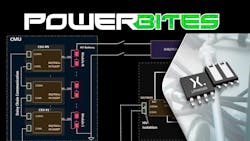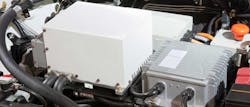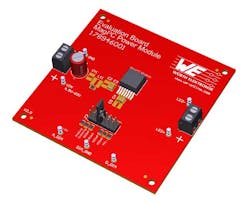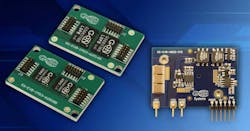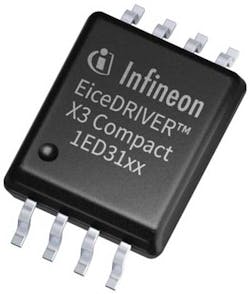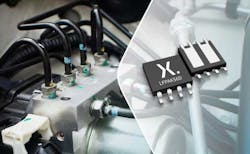This Week in PowerBites: Vanquishing Battery Vampires, Tough FETs
>> Electronic Design Resources
.. >> Library: Article Series
.. .. >> Article Series: PowerBites
The pandemic hasn't given anybody a chance to be naughty this year, so Santa asked us to stuff the holiday edition of PowerBites chock-full of treats for our readers. We hope you enjoy the two tutorials, the heaping helping of product reviews, and a look at how the electronics industry may chart the future for a profitable and sustainable future.
With best wishes to you and your loved ones for a happy and safe holiday, with the hope that we'll be back on your browser when the first edition of PowerBites goes live in 2021.
Everything You Wanted to Know About SiCs (but were afraid to ask)
Electronic Design has published a practical tutorial from STMicroelectronics on the characteristics of silicon-carbide (SiC) transistors and how they can be used to deliver improved efficiency and performance in some power-conversion applications. It begins with an overview of wide-bandgap (WBG) materials and how their characteristics influence the main parameters of the power transistor and its features and behavior in practical applications. This is followed by two practical examples of ways in which SiC's characteristics can be applied to the totem-pole bridgeless PFC topology and a half-bridge inverter.
Those topologies can be used in wide variety of applications ranging from motor control to uninterruptible power supplies and renewable-energy generation systems. Both examples provide details of their design methodology as well as analysis of their performance in terms of power losses, frequency response, and thermal performance. Click here to read the tutorial.
Eval Board for LED-Lighting Apps Offers Improved Current Control and Dimming
Würth Elektronik's new LDHM Evaluation Board for its LED step-down high-current power module (aka the MagI³C-LDHM) is intended to help designers accelerate the development of LED power supplies for a wide range of lighting applications. These dc-dc converters integrate a controller IC, and most of the inductors and capacitors needed to create a compact, cost-effective supply. The LDHM Evaluation Board provides the small handful of other components needed to create an efficient and safe LED driver that delivers up to 450 mA to power up to 16 LEDs in series, and supports both analog and pulse-width-modulation (PWM) dimming functions.
With an input voltage range of 4.5 to 60 V and a jumper-selectable output of up to 450 mA, Würth’s power module enables developers to quickly create LED solutions for a wide variety of indoor and outdoor applications (RGBW lamps, horticulture lamps)—at up to 95% efficiency. The protective circuit integrated in the LDHM controller protects the electronics against thermal overload, electrical damage, and LED short circuits. The thermally optimized layout meets the EMC requirements of EN55032/CISPR32 Class B. For quick design-in, the Gerber data are available for free download on the product page.
The Evaluation Board LDHM is available from stock. The corresponding power module can also be ordered from stock in any quantity without a minimum order quantity. Würth Elektronik provides free samples of the module.
GaN-Based Half-Bridge Designs Feature Advanced Insulator for Cooler Running, Increased Power
GaN Systems released its next-generation Insulated Metal Substrate (IMS3) application platform for use with its GaN E-HEMTs in high-power, high-efficiency automotive, data-center, and industrial applications. It features significantly improved heat transfer, making it an ideal reference for implementing smaller and lower-cost systems at the same power level or alternatively increasing output power by 30% in the same size. The platform consists of the IMS3 motherboard and a half-bridge power board, which is available in two power levels up to 3 kW (GS-EVB-IMS3-66508B-RN) and up to 6 kW (GS-EVB-HB-66516T-RN).
The half-bridge devices are mounted on an IMS circuit board that offers much improved heat-transfer properties, thanks to its extremely low thermal resistance. In this application, the IMS3 shows a 29% improvement in Rth_Case-to-heatsink over conventional solutions. The boards can be used with the new GS-EVB-HBDB-IMS optimized half-bridge isolated driver board and are compatible with the GSP665HPMB-EVBIMS2 high-power full-bridge driver board. The GS-EVB-IMS3-66508B-RN, GS-EVB-HB-66516T-RN, and GS-EVB-HBDB-IMS are available for purchase through GaN Systems distributors.
Compact Gate Driver's Small Footprint Enables Fast, Easy Design-Ins
Infineon Technologies AG expanded its EiceDRIVER 1ED family of compact isolated gate drivers with the X3 Compact series (1ED31xx), developed for use in industrial drives, solar systems, EV charging, uninterruptible power supplies, commercial air conditioning, and other applications. The series includes drivers that have been optimized for superjunction MOSFETs such as CoolMOS, SiC MOSFETs like CoolSiC, and IGBT modules. They’re designed for markets that demand easy-to-use drivers with a small footprint for quick design-ins. With a 40-V absolute maximum output supply voltage, they’re a perfect fit for rugged environments.
The EiceDRIVER X3 Compact series combines separate output options with active shutdown and short-circuit clamping in a space-efficient DSO-8 300 mil package. The active Miller clamp option is best suited for SiC MOSFETs with a 0 Vturn_off. All devices in the series have a demonstrated CMTI of 200 kV/μs, and are recognized under UL 1577 with an insulation test voltage of 5.7 kV rms. Its 14-A output current is well-suited for high switching frequency applications as well as for IGBTs that require higher gate currents.
The drivers are also designed to avoid faulty switching patterns, thanks to their low propagation delay matching (7 ns max.), resulting in shorter deadtimes. All variants integrate input filters, which reduces the need for external filters, provides accurate timing, and leads to lower BOM cost.
Availability
The EiceDRIVER X3 Compact can be ordered now, as can the evaluation boards EVAL-1ED3121MX12H, EVAL-1ED3122MX12H, and EVAL-1ED3124MX12H. Additional product details, including data-sheets and pricing, is available at EiceDRIVER 1ED Compact Gate Driver ICs - Infineon Technologies.
Dual MOSFETs Offer Guaranteed Repetitive Avalanche Performance for Automotive Solenoid Control
Nexperia's new AEC-Q101-qualified repetitive avalanche application-specific FET (ASFET) portfolio targets powertrain applications. The technology has been tested to one billion avalanche cycles and can be used to control automotive inductive loads such as solenoids and actuators. In addition to providing a faster turn-off time (up to 4X), the dual-MOSFET device enables simpler designs with a reduced BOM count.
The ASFETs offer an alternative to the three commonly used MOSFET-based power topologies for solenoid and actuator control in automotive powertrains: boost, free-wheel diode, and active clamp. A fourth option is a repetitive avalanche design that dissipates energy from the inductive load by making use of the MOSFET’s ability to repeatedly handle current from the inductive load during switch off. Providing comparable efficiencies to active clamp alternatives, such designs eliminate the need for diodes and other devices to minimize component count and circuit complexity.
The devices also support faster switch-off times, a factor that can extend the reliability of electromechanical components such as solenoids and relays. When compared to boost topologies, they can simplify designs by providing up to 30% component footprint efficiency due to a possible reduction of up to 15 board components.
Fully automotive-qualified to AEC-Q101 at 175°C, the new MOSFETs are available in 40- and 60-V options with typical RDS(ON) ratings from 12.5 to 55 mΩ. All of the devices are supplied in the company’s space-saving LFPAK56D (Dual Power-SO8) copper-clip package technology. The robust package features gull-wing leads for increased board-level reliability, and improved manufacturability including automated optical inspection (AOI).
For more information, including Quick Learning videos, click here.
Power-Management IC is Tailored for Laptops with UHD Displays
A new line of power-management integrated circuits (PMICs) from MagnaChip Semiconductor Corp. introduces a device specifically tailored to the requirements of UHD display panels in laptops. The new PMIC integrates one boost regulator for the power supply to the source and gate drivers, three high-current buck regulators for the power supply to a timing controller, two op amps for a gamma buffer, and one a set of positive and negative charge pumps. It controls electricity consumption through I2C technology, which ensures that functions such as dynamic voltage management, on/off block, protection circuit fault flag, and switching-frequency transition in UHD display panels are performed seamlessly.
Other features include fast transient response and enhanced circuit protection measures, including overvoltage protection, short-circuit protection, undervoltage lockout, overcurrent detection, overcurrent limit, and thermal shutdown. In addition, the PMIC offers a constant-current mode and dynamic switching frequency, which gives product designers more flexibility in meeting specific requirements of application. Visit www.magnachip.com for more information.
Vampire Slayer: Designing BMUs that Don't Kill the Batteries They Protect
In a recently published article, Texas Instruments introduced a simple solution to a problem that limits the unplugged standby time of many EVs and PHEVs. At present, nearly all electric vehicles have a secondary 12- or 48-V battery that remains on even when the car is parked or turned off to support features like remote key entry, security, and monitoring the health of the vehicle's main battery pack. When the car is parked, the battery-management unit (BMU) must periodically wake up to look for faults in high-voltage battery packs, a function that discharges the 12/48-V battery and limits the length of time the vehicle can remain unplugged to a few weeks.
This article introduces an alternate technique for monitoring battery health that draws much less power from the vehicle's low-voltage battery. Known as "host reverse wake-up," the new architecture enables the host BMU's microcontroller to be off, relying instead on the high-voltage battery's supply PMIC to remain in a low-power monitoring mode, thereby conserving 12-V battery power. The complete article can be accessed by clicking here.
It Isn't Easy Being Green—But It Can be Very Profitable!
For many companies, the growing consensus that the global economy must rapidly evolve to battle climate change is a new and difficult challenge that may threaten their profitability. For other more far-sighted companies, it’s both an obligation and an opportunity that they began to address years, or even decades earlier.
A case in point is STMicroelectronics, a company that has shown that while it may not be easy to be green, it can be very profitable. After recently reporting strong third-quarter performance (despite the pandemic), the company announced that it expects to achieve full compliance with the 1.5°C scenario defined at the Paris COP21 by 2025, and achieve 100% carbon-neutral operation by 2027. Far from an overnight success, this is the culmination of a corporate-wide environmental program that it put into play back in the mid-1990s.
Surprisingly, the company's environmental initiatives have consistently resulted in improved profitability, both from reduced operating costs and from the early lead it gained and held in the market for energy-efficient technologies and products that go into renewable power generation, electric vehicles, industrial equipment. and other products necessary to build a sustainable economy.*
One example of STMicroelectronics’ leadership is the “Sustainable Technology Program” started in 2011, in which a product's design process includes consideration of its environmental impact throughout its lifecycle, including responsible sourcing, eco-design, manufacturing, transportation, usage, and end-of-life processing. The percentage of ST's new products that are classified as “responsible” increased from 50% in 2018 to 62% in 2019. By 2025, the company expects to enjoy triple the percentage of revenue generated by responsible products versus 2016.
Electronic Design is working on a short feature that will look deeper into the technologies and business strategies that have enabled them to put green into both sides of their double bottom line. If you can't wait, you can follow the embedded links to read a press release that provides some details on ST's carbon-neutrality achievement, its 2019 Sustainability Report that provides even more details, and the sustainability guidelines that made it all possible.
*For FY 2019, STMicroelectronics reported net revenues of $9.56 billion with a gross margin of 38.7%.
>> Electronic Design Resources
.. >> Library: Article Series
.. .. >> Article Series: PowerBites
